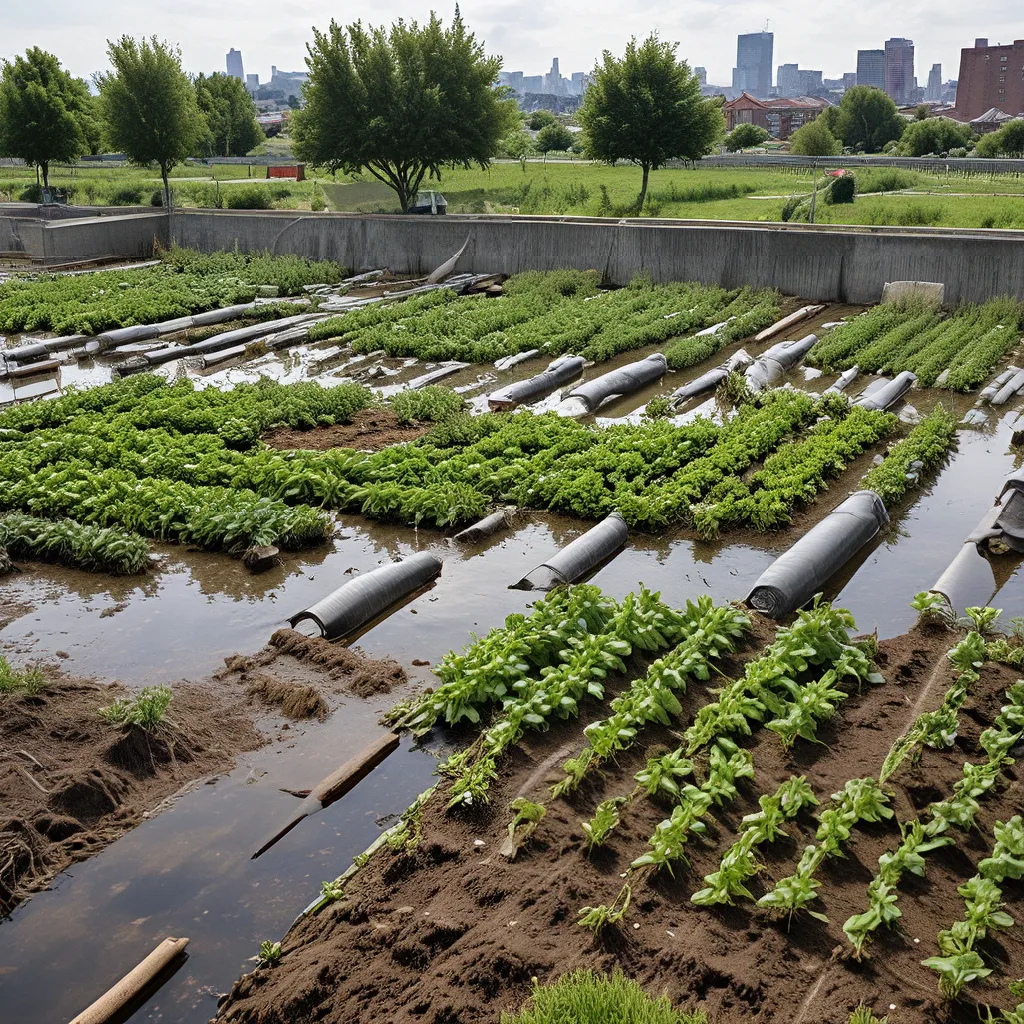
The Untapped Potential of Wastewater
I’ll never forget the day I first learned about the true potential of wastewater. It was during a sustainability conference, where a panel of experts was discussing innovative ways to tackle urban environmental challenges. One speaker, a brilliant researcher named Dr. Amelia Greene, made a statement that stopped me in my tracks: “What if I told you that the solution to our food security and nutrient scarcity issues could be found right under our feet?”
Intrigued, I leaned in, eager to hear more. Dr. Greene went on to explain how urban wastewater, long considered a mere waste product, could actually be a rich source of nutrients and organic matter – essential ingredients for sustainable agriculture. Her words opened my eyes to a whole new world of possibilities, and I knew I had to explore this topic further.
Recent studies have shown that the reuse of treated wastewater for urban agriculture can not only help close the nutrient loop, but also contribute to water conservation and food production in resource-constrained cities. By tapping into this underutilized resource, we could revolutionize the way we approach urban sustainability and food security.
Unlocking the Nutritional Goldmine
As I delved deeper into the research, I was amazed by the sheer nutritional value of wastewater. Treated effluent from wastewater treatment plants is often rich in nitrogen, phosphorus, and potassium – the three primary macronutrients essential for plant growth. Additionally, it can contain organic matter, micronutrients, and trace elements that can improve soil health and enhance crop yields.
Table 1: Typical Nutrient Concentrations in Treated Wastewater
| Nutrient | Concentration (mg/L) |
|---|---|
| Nitrogen (N) | 10-50 |
| Phosphorus (P) | 2-15 |
| Potassium (K) | 10-30 |
Studies have shown that the nutrient-rich nature of treated wastewater can reduce the need for synthetic fertilizers in urban agriculture, leading to significant cost savings for farmers and environmental benefits by reducing the carbon footprint associated with fertilizer production and transportation.
Moreover, the organic matter in wastewater can improve soil structure, water-holding capacity, and microbial activity, ultimately enhancing the overall health and productivity of urban soils. This is particularly crucial in dense urban environments, where soil quality is often compromised due to compaction, contamination, and limited natural inputs.
Bridging the Urban-Rural Divide
One of the most exciting aspects of wastewater reuse for urban agriculture is its potential to bridge the gap between urban and rural areas. Traditionally, food production has been concentrated in rural, agricultural regions, while urban areas have been heavily dependent on external food sources.
By harnessing the power of wastewater, cities can become more self-reliant in terms of food production, reducing the environmental and economic costs associated with long-distance food transportation. This, in turn, can lead to stronger local food systems, improved food security, and greater resilience in the face of global supply chain disruptions.
Moreover, the integration of wastewater reuse into urban agriculture can create new economic opportunities for urban farmers and small-scale producers. By reducing the need for costly fertilizers and improving soil fertility, wastewater-based urban farming can boost crop yields and profitability, ultimately empowering local communities and fostering a more sustainable food system.
Overcoming Challenges and Misconceptions
Of course, the implementation of wastewater reuse for urban agriculture is not without its challenges. One of the primary concerns is the potential presence of contaminants, such as heavy metals, pathogens, and micropollutants, in the treated wastewater. Careful monitoring and advanced treatment technologies are essential to ensure the safety and quality** of the water used for irrigation.
Additionally, there may be cultural and social barriers to acceptance of wastewater reuse, as some communities may have preconceived notions or misconceptions about the safety and cleanliness of using treated wastewater. Effective public education and community engagement efforts are crucial to address these concerns and build trust in the sustainability and benefits of this approach.
Alpha Wastewater, a leading provider of wastewater treatment services, has been at the forefront of addressing these challenges. By implementing advanced treatment processes and collaborating with local authorities and community groups, they have been able to successfully integrate wastewater reuse into urban agriculture projects, demonstrating the immense potential of this approach.
Embracing the Future of Sustainable Urbanism
As I reflect on my journey of discovery, I am excited by the prospects of wastewater reuse for urban agriculture. Closing the nutrient loop not only addresses critical sustainability and food security concerns, but also opens up new avenues for innovative urban planning and community-driven initiatives.
Imagine a future where city streets are lined with thriving urban farms, nourished by the very wastewater that was once considered a waste product. A future where rooftop gardens and vertical farms are fed by a decentralized network of wastewater treatment systems, empowering local communities to grow their own food and reduce their ecological footprint.
This is not a distant dream, but a real and tangible possibility that is gaining traction around the world. Researchers, policymakers, and industry leaders are working tirelessly to overcome the barriers and unlock the full potential of this transformative approach to urban sustainability.
As I continue to explore this fascinating topic, I am inspired by the innovative and collaborative spirit that is driving this movement. I encourage you to join me in exploring the exciting world of wastewater reuse for urban agriculture, and to become a part of the solution that will shape the future of our cities and communities.